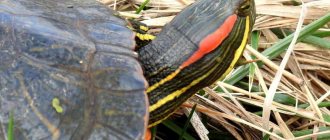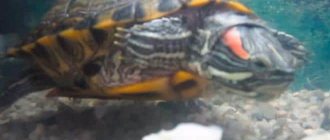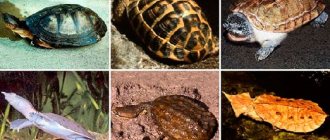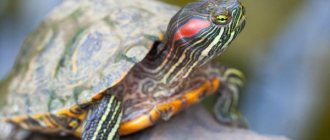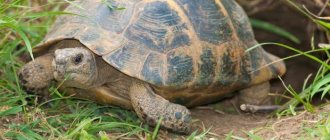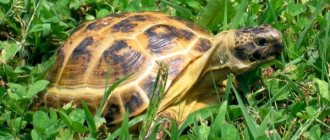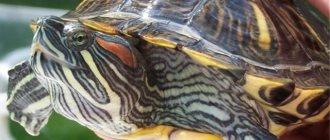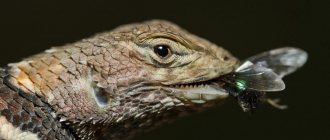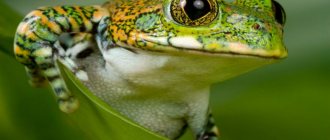Brief description of this type
The shell of a fairly mature turtle is usually covered with wrinkles. Its length depends on the specific subspecies and, as a rule, reaches 28 centimeters. The red-eared turtle has a small spot near its eyes.
The peculiarity is that their colors are diverse and tend to change over the years. Thus, in youth they are green in color, and in old age they are completely black. The ventral shield of the carapace is bright yellow with darkish round spots. A turtle grows as follows: for the first year and a half of its life, its height reaches 7.5 cm, then the pace becomes slower and it increases by only 1.25 cm per year. In two years, growth can be more than 20 cm, that is, it is mistaken to consider it dwarf. And you shouldn’t listen to sellers who convince you otherwise. The length of the Scripta Scripta species reaches approximately 27 cm. This turtle has a bright yellow postorbital spot. Its plastron is a rich yellow color.
Another subspecies is Elegant, has a length of 28 centimeters. A reddish postorbital stripe is located on the head, and there are narrow stripes on the chin. The ventral shield of the carapace has large spots on all scutes.
The third species of turtle, Scripta Troostii, has the shortest length of all - about 21 centimeters. There is a narrow yellowish postorbital stripe on the head, and wide stripes on the chin. And its plastron consists of unusual patterns in the form of “eyes”, and sometimes of ordinary small black spots.
Conclusion
Before purchasing a red-eared turtle, carefully read the maintenance instructions. Improper conditions can lead to the death of the animal.
It is necessary not only to know the needs and features of care, but also to have the appropriate equipment in your aquaterrarium.
Remember that in addition to the aquatic environment, you should arrange a corner of land and maintain the proper temperature. Monitor the cleanliness and condition of the water so that your red-eared pet lives in a comfortable environment.
What to feed the red-eared slider
As for young turtles, they need animal food for active vital growth of the body. In this regard, it should be given once a day, but no more. Also, the aquarium should have various algae and any other plants that are edible for turtles.
Adult turtles are individuals that are much larger than 12 centimeters. They must eat food once every two or three days and half of their diet must be some kind of vegetation. The aquaterrarium should contain any edible plants so that the turtles can eat them between meals.
The amount of food given is determined based on the size of the turtle. For kids, the norm is two or three pieces of one cubic centimeter, and for older turtles - two or three pieces several times larger in size.
It is necessary to ensure that the food is at a suitable room temperature and must have a raw consistency. It is important to remember that young turtles are, first and foremost, predators. Their main food is fish. You can add live fish to the aquarium that they cannot eat. It is necessary to diversify the diet given and not feed only gammarus and dry food. And adult turtles are omnivores. They eat both animal and plant food.
Types of feed
As for fish, it is useful for turtles to eat pollock, gobies, cod, blue whiting and any other fish, but not fatty ones. The liver can be beef, or you can also give liver or chicken heart. From insects and crustaceans: non-dry gammarus, earthworms, daphnia crustaceans, legless crickets, beetles. You can diversify the food served to them with the help of small snails, mollusks, squids, frogs, small tadpoles; you should not get carried away with seafood, since any turtle is itself a sea turtle. Aquatic plants are not prohibited from plant food: duckweed, hyacinth and others. In addition, it can be dandelion, daisies and any non-poisonous meadow flowers and plants. It is not advisable to give vegetables other than carrots and lettuce.
It is strictly forbidden to give turtles any meat: any minced meat, sausages, beef, sausage, lamb, chicken, pork, etc. Fatty fish, cheese, fruit and bread are prohibited. It is better to avoid dry food.
If the aquarium is well equipped, has ultraviolet lighting, and appropriate temperature conditions, then vitamins may not be included in the diet. But, in the case when the conditions are far from ideal, it is necessary to remember about the vitamin and mineral base. Vitamins are already included in the food specifically for this purpose.
Maintenance and care
Keeping a red-eared turtle at home is simple, and even an inexperienced person can do it, but certain nuances still need to be observed. The pet’s health and life expectancy depend on them, so the first thing you need to do is organize a spacious terrarium for the reptile. We’ll talk further about what kind of aquarium is needed for a red-eared turtle and what should be in it.
Arrangement of the terrarium
A red-eared turtle at home will grow and develop normally in a terrarium with a volume of 150 liters or more. The height must be greater than the width so that the turtle can turn over freely. The liquid level should be such that a reptile standing on its hind legs could stick its muzzle out of the water.
An aquarium for a red-eared turtle must be equipped with an island with a gentle bank so that the pet can easily climb onto land. When placing decorations, preference should be given to driftwood, previously soaked and treated to remove dirt and bacteria, or non-toxic plastic elements. There is no need to plant living flora - this is exactly what red-eared turtles eat, since not a trace of the plants will remain. When using a substrate, choose a large, smooth soil.
In addition to sushi, 40 and 60 W bulbs are installed in the turtle aquarium at a distance of 25 cm. Otherwise, the light will disturb the pets. Reptiles need an ultraviolet lamp to produce vitamin D3, so experienced aquarists use Repti Glo 5 and 8 devices. The source of ultraviolet rays is located at a distance of 40 cm, otherwise the pet will get burned.
Read more about what kind of aquarium is needed for a red-eared slider in a separate article (link).
Water environment
Turtles spend most of their time in water, so it is important to pay attention to the aquatic environment in the terrarium. Reptiles prefer clean, clear liquid, so installing a filter in the container is a must.
The liquid used to fill the terrarium is settled, without chlorine and harmful impurities. The water temperature for red-eared turtles is 22-28C. To maintain the number of degrees you need a heater and a thermometer. The fluid is renewed weekly, replacing 1/3 of the volume. It is important to note that the well-being and life of reptiles depends on the attention of the owner in this matter.
Walks
Owners of a red-eared slider, no matter how cute the reptile may seem, should know that they should not let their pets sit on the floor. Turtles tend to get scared in a new place, so they can bite and painfully scratch their owner. After contact with reptiles, you should wash your hands, since pathogenic bacteria accumulate on the shell of animals.
In the summer, the red-eared turtle is taken for a walk, where the pet receives natural ultraviolet rays and feasts on fresh grass. A place for walking is chosen away from roadways, with a flat, clean lawn. The walk time is 30 minutes, the temperature outside in the shade should be 20C, otherwise the pet will become exhausted. You should take a bowl with clean water with you so that the turtle can drink.
Feeding
Adult reptiles are fed 2-3 times a week, young pets are fed daily. Food for red-eared turtles should include the following products:
- Live lean fish: blue whiting, gobies, etc.
- Raw meat.
- Various types of insects: crustaceans, bloodworms, daphnia, etc.
- Squid, shrimp, snails, frogs.
- Vegetation: lettuce, cabbage, dandelion and other plants.
- Vegetables: carrots, apples, cucumbers.
It is strictly forbidden to feed your pets cheeses, lamb, flour and bakery products, pork, fruits and other fatty and human products. To prevent diseases, turtles are given calcium supplements and vitamins.
Read more about what to feed a red-eared slider at home in a separate article.
Reproduction
Puberty occurs differently in females and males and this is also influenced by their lifestyle. If they are in captivity, then this period begins at 4 years for males and at 5-6 years for females. And in the wild they reach maturity at about 8 years of age. The mating season begins in the spring: in March - April. Their process is as follows: the male crawls very close to the female, sticks his muzzle into her and tickles her chin with long claws.
The eggs laid do not exceed 4 cm in size. They are laid on land, not in water. But the place for the eggs must be moist, so the female moistens it with water from the anal bladder and then digs out a small hole. Female turtles lay no more than 10 eggs in their nests, which are subsequently buried. The incubation period is up to 150 days. An interesting feature with temperature. If the temperature remained above 30 degrees, then females hatch, and if below 27, males hatch.
Sense organs
This animal is distinguished by a high level of development of sensory organs. The main features are as follows:
- Vision. Red-eared turtles distinguish colors, choose the most suitable places to lay eggs, and look for other turtles. They also see moving objects, the distance to which can reach 40 m, well distinguishing predators and prey from each other.
- Smell. These reptiles search for food thanks to their developed sense of smell.
- Hearing. These animals hear poorly. This is due to the fact that their ears are hidden under the skin. Therefore, red-eared turtles react only to vibration.
- Touch. The turtle's shell is equipped with nerve endings, so it feels touch. The presence of taste buds allows these creatures to choose tastier foods.
- Voice. The vocal apparatus of turtles is not developed; they are only capable of snorting and hissing. Sometimes they make a squeak.
What should an aquaterrarium be like for a red-eared turtle?
It should be quite long, but at the same time not wide and low. Volume not less than 120 liters. The water level must match the proportions of your turtle's shell so that it can turn over. A small bank should be installed near the aquarium. Maintain the water temperature within 25 degrees, on land - 31 - 33 degrees. To keep the temperature at the same level, a special heater must be provided.
The water must be changed and cleaned depending on the degree of contamination. But you can also use a special filter. For young turtles, external is preferable, and for adults, only internal. An ultraviolet lamp will not hurt, but it should not be located low, the approximate height is 25 cm, so that the turtle does not get a burn to the eyes. Another option for arranging an aquaterrarium is an incandescent lamp with the same requirements. They both need to switch off at night.
If the weather outside is nice and warm, try to take the turtles out to bask more often. But remember that the first time you do not need to keep it in the sun for more than 5 minutes. And it is important to increase the time spent in the fresh air gradually. They also need a dark place where they can periodically hide from the sun, as they are susceptible to overheating.
Some guidelines have been developed regarding temperature and lighting duration for all turtles of this species. This is not mandatory, but highly recommended for adults.
So, for the remaining two turtles from January to March the temperature should be 18 degrees, and the duration of illumination should be 8 hours, April - 21/8, where 21 is the temperature, and 8 is the duration of illumination, May - 24/10, June - 27 /13, July – 28/13, August – 28/11, September – 25/10, October – 22/8, November and December – 18/8.
And for Trachemys scripta troostii the requirements are as follows: January - March - 18/8, April - 20/8, May - 21/10, June - 23/13, July - 26/13, August - 25/11, September - 20/ 10, October – December – 18/8.
The turtle does not leave its shelter and refuses to eat
This may occur in mid-summer or late autumn. It is during these periods that the turtle can go into summer or winter hibernation. Despite this, a turtle’s refusal to eat may indicate the presence of magnetic storms, changes in pressure or weather. In any case, the optimal temperature should be maintained during the day (26-28 degrees) and at night (22-24 degrees). After some time, the turtle begins to behave as usual.
In conditions where the temperature was maintained at the proper conditions precisely during periods when the turtle can hibernate, and the turtle refuses to eat and does not leave its shelter, it most likely became ill.
